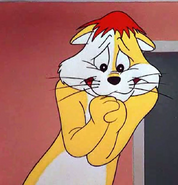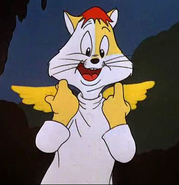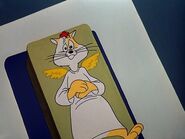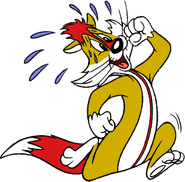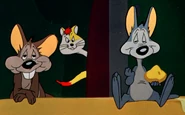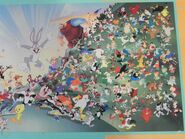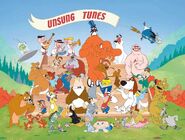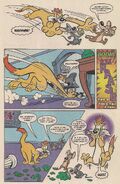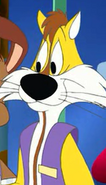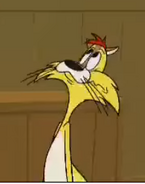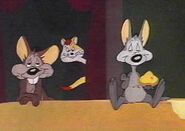Claude Cat is a Looney Tunes and Merrie Melodies character.
Name[]
The name Claude Cat is a pun on the homonym "clawed cat".
History[]
Claude had his origins in several other cat characters used by Chuck Jones from 1943 to 1946. These unnamed cats were mostly similar in appearance and temperament, with black fur and anxious personalities. For example, in the 1943 film "The Aristo-cat" (the character's first speaking role), Chuck paired his unnamed cat against the mind-manipulating mouse duo, Hubie and Bertie.
Jones redesigned the neurotic feline for the 1949 film "Mouse Wreckers", perhaps to distinguish him from Friz Freleng's popular puss, Sylvester. The short is another Hubie and Bertie vehicle, only this time, they antagonize Claude, drawn as he would appear in all future cartoons: yellow, with a red shock of hair, a black nose, a white belly, and a bushy tail, though his exact markings would vary. In this, as in all future Claude Cat cartoons, Jones' careful attention to personality is easily evident. Claude is a nervous and lazy clawed animal. His attempts to protect his home from the manipulative mice Hubie and Bertie prove futile as the rodents torment him by, among other things, putting aquariums in all the windows to make Claude think he's underwater or by nailing his furniture to the ceiling.
Jones set the mice on Claude once more in the 1950 film "The Hypo-Chondri-Cat". This time, the miniature mice convince the neurotic and hypochondriac Claude that he's dead. Claude would run afoul of the mice once more in 1951's "Cheese Chasers" where a suicidal Hubie and Bertie force themselves to be eaten by Claude against his will to the point that he even forces himself to be massacred by a bulldog against his will just like the mice, followed by the bulldog doing the same to the passing by dogcatcher, causing Claude and Hubie and Bertie to chase each other from behind.
In another 1950 film, "Two's a Crowd", Claude is scared out of his mind by a diminutive dog named Frisky Puppy, newly adopted by Claude's owners. The main theme, however, is jealousy as Claude's attempts to oust the intruder repeatedly fail due to the cat's intense cowardice. A running gag has Claude repeatedly shooting up and clinging to the ceiling after the pup playfully comes up behind him and barks. Jones repeated the scenario with slight variations in "Terrier-Stricken" in 1952 and "No Barking" in 1954, the latter featuring a cameo by Tweety.
In future cartoons beginning with "Mouse-Warming", Jones recast Claude as a silent villain, still possessing his full set of neuroses. In that short, he interferes with the romantic relationship between a pair of teenage mice so that he could eat the boy mouse, either by fooling the boy mouse with forged love letters from the female mouse, and then by forging a threat letter to fool the female mouse's family to pin the blame on the boy mouse. By the end of the short, the boy mouse retaliates by fooling Claude with a forged letter from the household bulldog Butcher inviting the cat for a friendly game of canasta, which Claude immediately falls for it hook, line and sinker and receives a huge beating from Butcher.
Claude's more villainous evolution reaches its peak in the 1954 film "Feline Frame-Up" where here, Claude convinces his owner that fellow pet Marc Antony is trying to eat the kitten Pussyfoot. Marc Antony is tossed out, allowing Claude the run of the house. That is, until Marc Antony outwits the cat and makes him sign a confession admitting to his crimes. Jones repeated the scenario with a slight variation in "Cat Feud" in 1958, where Claude, who is depicted as an alley cat, attempts to steal Pussyfoot's wiener away from her, resulting her new guardian Hector the Bulldog to fight the cat on the steal beams of a construction building.
Claude's final cartoon was 1962's "Louvre Come Back to Me!" where he is a French cat named Pierre who loves Penelope Pussycat. Afterwards, Jones retired Claude in the early-1960s, as he was concentrating on other characters such as Wile E. Coyote and Ralph Wolf and Sam Sheepdog. Nevertheless, the character enjoys some popularity as one of Jones' more humorous creations.
Claude was played by voice actor Mel Blanc, and later John Kassir and Eric Bauza, using a quirky, strangulated voice similar to that of Marvin the Martian, but without Marvin's precise enunciation. While most of the cartoons depict Claude as a silent character, he did speak in "The Aristo-Cat", "Odor-Able Kitty", "Roughly Squeaking", The Hypo-Chondri-Cat", "Cheese Chasers", and only once at the end of "Feline Frame-Up".
In the 2006 direct-to-video movie Bah, Humduck! A Looney Tunes Christmas, Claude Cat has a very brief cameo as an employee going home for Christmas. Claude has appeared in the opening to The Looney Tunes Show. He appears in several episodes of New Looney Tunes, such as "Tweet Team", "DarkBat", and "Puppy's Got Claws", where he often teamed up with Sylvester and Pete Puma as a feline comedy trio.
Claude appeared in the Looney Tunes Cartoons episode "Frame the Feline", once again paired with the mice duo Hubie and Bertie.
One of the versions of Claude Cat was planned to be made as a cameo in the deleted scene "Acme's Funeral" from the 1988 film Who Framed Roger Rabbit. He appears with other animated characters scared when Casper appears at the funeral. [1]
Filmography[]
Cartoons[]
 "The Aristo-cat" (1943)
"The Aristo-cat" (1943) 
 "Fin 'n' Catty" (1943)
"Fin 'n' Catty" (1943) 
 "Odor-able Kitty" (1945)
"Odor-able Kitty" (1945) 
 "Roughly Squeaking" (1946)
"Roughly Squeaking" (1946) 
 "Mouse Wreckers" (1949)
"Mouse Wreckers" (1949)  (Academy Award nominee)
(Academy Award nominee) "The Hypo-Chondri-Cat" (1950)
"The Hypo-Chondri-Cat" (1950) 
 "Two's a Crowd" (1950)
"Two's a Crowd" (1950) 
 "Cheese Chasers" (1951)
"Cheese Chasers" (1951) 
 "Mouse-Warming" (1952)
"Mouse-Warming" (1952) "Terrier-Stricken" (1952)
"Terrier-Stricken" (1952) "Feline Frame-Up" (1954)
"Feline Frame-Up" (1954) "No Barking" (1954)
"No Barking" (1954) 
 "Cat Feud" (1958)
"Cat Feud" (1958) "Louvre Come Back to Me!" (1962)
"Louvre Come Back to Me!" (1962)
In other media[]
- Daffy Duck's Movie: Fantastic Island
- Who Framed Roger Rabbit (cameo; deleted)
- Space Jam
- Bah, Humduck! A Looney Tunes Christmas
The Looney Tunes Show (intro only)
New Looney Tunes episodes:
- "Tweet Team"
- "DarkBat"
- "Puppy's Got Claws"
- "CinderPorker"
- "It Paint All It's Cracked Up to Be"
- "The Legend of Burrito Monday"
Looney Tunes Cartoons episodes:



